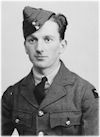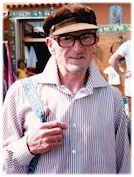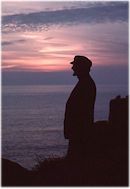Biography
 Tom Alderson was born in the small Durham mining village of Coundon on the 23rd April 1920.
Tom Alderson was born in the small Durham mining village of Coundon on the 23rd April 1920.
His father was a pitman and was adamant that his son would not follow him into mining and so encouraged him to look to the wider world for employment.
He left school at 14 and worked in a market garden for a while before accepting work in service for Captain George Eyston's family at their home
at East Hendred in Oxfordshire.(although it was in Berkshire at the time Tom was there)
So at the age of 16 Tom moved south and from 1936 to 1939 worked for the Eystons and Sir Charles Pulley (Baronet) at his Park Lane address in London.
 At the start of the World War II he joined the RAF and as part of the ground support unit was posted to Manston, Cardington and Torquay.
At the start of the World War II he joined the RAF and as part of the ground support unit was posted to Manston, Cardington and Torquay.
He always kept fit by playing football, cricket and boxing.
In 1945 he married Olga Cooper, a girl from his home village and after demob in 1946 they moved to Birmingham where he had secured a job working for one of his ex-RAF officers.
However family commitments meant that in 1948 they moved back north to Coundon and Tom worked for a while as a tailors' cutter.
Ever since his school days he had been interested in art and on hearing about the Spennymoor Settlement
he became a member of their Saturday afternoon sketching club alongside mining artists
Tom McGuinness
and Norman Cornish .
There were no formal teachers at these club meetings and the necessary constructive criticism was often just discussions held at Norman's house after the meetings.
However, Tom's inspiration did not come from a mining background but from a wide variety of subjects. Abstract interiors of Durham Cathedral, the colour and movement of fun fairs, portraits, still life, and landscapes all featured in his work.
Encouraged by Spennymoor Settlement warden, Bill Farrell, Tom enrolled for evening classes at Darlington School of Art and displayed paintings at the Settlement and the Darlington Society of Arts annual exhibitions, during the late 1940's and early 1950's.

In 1954 as a mature student aged 34 he won a 3 year scholarship to the Central School of Art and Design in London (now
Central St. Martins College of Art and Design) where he studied for an N.D.D. in fine
art and commercial design.
On completion of his course he was invited to stay on and lecture part time at the Central while studying for a 1 year A.T.D
post diploma in fine art.
In the late 1950's one of his main exhibition spaces was the Paintings Gallery at Liberty's in London and many of his paintings sold from there went to America.
While at the Central School he became friends with staff members David Haughton
and Patrick Heron and stayed with David at his house at St. Just
in Penwith several times on painting and sketching expeditions in Cornwall.
The landscape of Cornwall had a great impact on Tom and would feature many times in his work in later years.
Commercial design also played an important part in Tom's career. In 1959 he designed the symbol for 'World Mental Health Year' to use on their literature, die stamps and stick-on seals during 1960 and later, in 1965, several of his drawings were used in the Head Wrightson & Co Ltd. Research and Development brochure.
After a brief spell teaching art in Hucknell, in 1960 he accepted a post as lecturer at Middlesbrough College of Art (now Cleveland College of Art and
Design) in Middlesbrough and moved back to join his wife and two daughters in the village where he was born.
In 1967 he became Fine Art lecturer on the foundation course with his friend and colleague,
Joe Cole.
 Yorksire artist, Peter Hicks, was head of art studies at Queen Elizabeth College, Darlington at that time and he would visit Joe and Tom at Middlesbrough
to discuss the future program for students due to start on the Foundation Course. They were tutors for many of today's leading North East artists including
Len Tabner and
John Degnan.
Yorksire artist, Peter Hicks, was head of art studies at Queen Elizabeth College, Darlington at that time and he would visit Joe and Tom at Middlesbrough
to discuss the future program for students due to start on the Foundation Course. They were tutors for many of today's leading North East artists including
Len Tabner and
John Degnan.
Tom exhibited at most of the Cleveland College staff exhibitions and many of his contructivist abstracts based on the theme of Computers were sold to be placed in schools and colleges in the Yorkshire area.
He maintained his love of sport by competing in several staff versus students competitions at cricket and hockey and also, after teaching himself to play
the trumpet, running 'Tommy's Royal Jazzmen'.
This was to be his life until retirement in 1985.
After Joe Coles' sudden and untimely death in 1984 he became somewhat of a recluse, spending all of his time either painting or framing his pictures with several excursions travelling to Italy, the USA and his beloved Cornwall.
In early 1996 he was dealt a cruel blow when he was left unable to eat or drink after rupturing his oesophagus. After several massive operations he was,
at one stage, only given 48 hours to live but made an almost complete recovery learning to feed himself via a tube directly into his stomach.

He then slowly resumed painting full time holding his first solo exhibition for 25 years to celebrate the opening of Visual Arts Year 1996
In 1997 aged 77 he moved to a larger house in Coundon so he had more space for his paintings and where he could work on larger canvases.
His work progressed through many phases over his long career and he was still painting almost every day until 2 days before his sudden death aged 90 on 23rd October 2010.
Copyright © Tom Alderson Estate. All Rights Reserved







